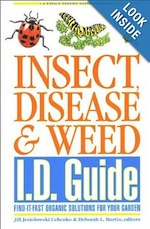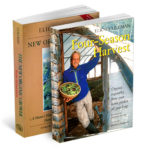Downloads
 Dealing With Pests Worksheet
Dealing With Pests WorksheetDownload the worksheet for this session. Space has been provided for those who would like to take notes. 🙂
Extra Resources

Insect Disease & Weed Control I.D. Guide
What is it? Why is it in your garden? How can you make it go away? Or should you try to keep it there? Use this book to know what's what in your garden, lawn, and landscape. Uncover the identity of each garden mystery you meet, them learn exactly what-- if anything-- to do about it. From banishing pests and diseases to wiping out weeds to creating a haven for garden good guys, you'll find safe, sensible, all-organic recommendations to help you make the best choices for our garden.
Or read it for free on Google Books here.
Basalt Dust
Basalt dust can be helpful in dealing with insects. The dust causes the insects to dehydrate and is also known to be a healthy additive to the soil.
Diatomaceous Earth
Diatomaceous earth kills a whole host of insect pests on contact. It contains fossilized remains of diatoms and kills by ingestion or by contact with the powder, which cuts the exoskeleton, causing dehydration within 48 hrs. Insects cannot develop a resistance to it since there are no chemicals to which they can build up an immunity.
Dipel
Dipel is specific to leaf-eating caterpillars and worms. This powder when eaten breaks down the digestive wall of the caterpillar or worm causing it to not be able to eat or digest food anymore. Caterpillars and worms usually die within 1-3 days.
Insecticidal Soap
This clear, soap-like liquid is composed of fatty acid salts and contains no petroleum additives and is labeled to control aphids, whiteflies, and spider mites on fruits, vegetables, and ornamentals.
Sluggo
A unique blend of mollusk bait and iron phosphate (a naturally occurring soil mineral that breaks down into fertilizer), this bait lures slugs and snails from their hiding places and plants. Ingestion causes slugs to stop feeding for immediate plant protection, and death within 3-6 days.
Suggested Reading
 For a deeper look into this module read the following:
For a deeper look into this module read the following:
Four Season Harvest: p. 122-123; 143-150
The New Organic Grower: p. 172-189
9 Comments
Kitty
May 25, 2014I have a serious infestation of this bug. This is the second year and worse than last season. All over brassicas-what can I do to save the harvest and get control over this enemy?
thank you for your reply.
Kitty
Kitty
May 25, 2014http://www.saferbrand.com/advice/insect-library/garden-insects/all-about-harlequin-bugs
This is the website of the bug that is all over my garden!
Paul
May 25, 2014Hi Kitty!
So sorry to hear about your infestation of harlequin bugs!
First of all, here is a great resource for dealing with harlequin bugs in a natural way: Dealing with Harlequin Bugs Organically
I really appreciate their approach especially because they start out with using preventative measures and seeking to grow healthy plants or resistant plants from the start rather than raging a huge war on the bugs. These are things to consider as you plant for the fall or for the following years. By building up your garden soil and focusing on preventative ways to keep harmful bugs at bay – over the years you can end up with less and less bug pressure. But, sometimes it just happens and you do end up with a huge bug infestation and you’d like to know what to do now.
If you need to do something about them now, you can of course start with hand picking them and putting them in a jar of soapy water (to kill them). I’ve heard of people even blending up the bugs in water and then spraying them back on their plants as a replant and supposedly it worked – but I won’t guarantee it and you might not want to get your blender dirty in that way. I’ll leave that up to you.
Otherwise you can try doing what they say here by using the insecticidal soap with Pyrethrin. Make sure the pyrethrin is certified for organic use and then follow the instructions that it comes with. It’s not the ideal to attack insects in this way in the garden because you can kill beneficial ones as well… but sometimes if you want to save the crop it is the last resort. Here is some more information on pyrethrin if you are interested to find out more.
Another thing you can try is using diatomaceous earth. This is also a natural way to kill insects but like the pyrethrin it needs to make direct contact with the insect.
I hope this helps out! Let me know how it goes and/or what you decide to do.
Serena
June 8, 2015Is Natural Guard good?
It has:
80% Silicon Dioxide, from diatomaceous Earth
10% other elemental oxides
05% Inert Ingredients
Paul
June 9, 2015I haven’t personally used Natural Guard but just from what I’ve looked at it looks like a good product. Diatomaceous Earth is definitely a natural product that I would suggest. I’m not sure what the other elemental oxides or inert ingredients would be. But it does seem to be a natural product for organic use.
Yonidy Chidzik
March 22, 2016What about using neem oil as insect control in the garden? What do you know about it. Thanks for sharing all you knowledge.
Paul
March 24, 2016Hi Yonidy, yes, I’ve heard that neem oil can work well! I haven’t personally used it myself but my Dad has a little. I’d encourage trying it out. I’d like to experiment with it myself too.
William Meadows
February 15, 2018For those who needing information on how to deal with ground moles.
In North central Florida we have ground moles – the following link from the University of Florida takes a positive plant approach in handling these pests – the article mention that the use of chemicals to kill the insects that the moles feed upon is NOT the proper approach to take because it is harmful to the environment.
http://gardeningsolutions.ifas.ufl.edu/design/gardening-with-wildlife/moles.html
Paul
February 16, 2018Great – thanks for sharing this William! 🙂